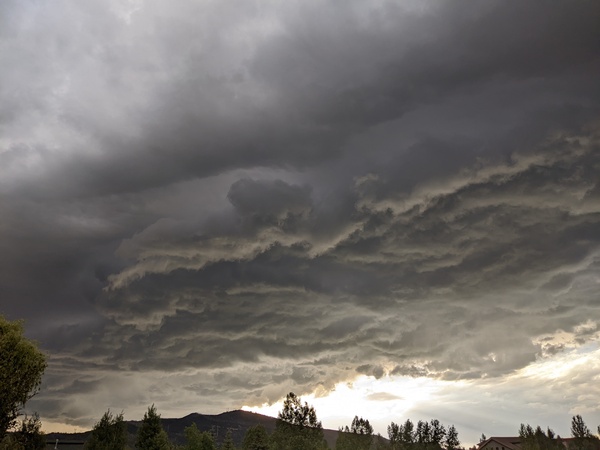Increasing moisture and decreasing temperatures after midweek
Monday, September 11, 2017
Lots to contend with this week, with now tropical storm Irma affecting the eastern third of the country, hurricane Jose spinning near Bermuda and possibly threatening the East Coast early next week, and, closer to home, a closed low pressure area off the California coast and a Pacific Northwest storm that will affect our weather starting around midweek.
There will be a chance of showers this afternoon and early evening as some moisture lingers over the Steamboat Springs area in continued above average temperatures. Tuesday will be as warm, but drier, before a strong storm in the Gulf of Alaska approaches the Pacific Northwest coast early Wednesday.
Seasonally building cold air in western Canada is forecast to mix with the storm, increasing its southern extent enough to incorporate the California low around midweek. Chances for showers increase again by Wednesday afternoon as energy and moisture from the storm complex moves toward the Great Basin and begins to affect our area.
Cooling temperatures and a much better chance of wetting rains for later Thursday and early Friday are likely as the old California low passes near or perhaps over northern Colorado. There is model disagreement with respect to the southern extent of this leading wave and how quickly a reinforcing wave of cold air moves over the area, but right now it looks like some drying for later Friday before we see another round of cooler and showery weather for the first half of the weekend.
Of note is the European ECMWF is much cooler with the reinforcing wave of cold air than the American GFS, possibly bringing some snowflakes to the upper elevations of Mt. Werner sometime this weekend if that model verifies.
Drier air and warming temperatures in southwest flow is advertised for later Sunday and the beginning of the next work week as the storm moves northeast of our area and another Gulf of Alaska storm approaches the Pacific Northwest coast.
Increasing moisture and decreasing smoke likely for the weekend
Thursday, September 7, 2017
A trough of low pressure approaching the Pacific Northwest will split today, with the southern piece forming a meandering closed low off the California coast and the northern piece moving eastward across the U.S. - Canadian border. The northern portion will move the ridge of high pressure currently over the western states east of the Steamboat Springs area by Friday afternoon, with weak southerly winds behind the ridge and ahead of the closed low off the West Coast directing moisture toward Colorado and smoke from the local wildfires to our northwest away from the city.
However, the southerly flow is not strong, so it is unclear how much smoke will be scoured from the area, though an improvement in air quality is very likely. Additionally, the weak flow will limit the amount of moisture that moves over our area, so the afternoon storms that may occur Friday, Saturday and possibly Sunday afternoons may produce more wind than rain.
By early in the work week, the western ridge partially reforms behind the eastward-moving wave forecast to be to our northeast, and this reintroduces drier air and weak northwesterly flow for northern Colorado. Therefore, if the local wildfires to our northwest are still producing smoke, we may once again have some smokey and hazy days next week.
Another Pacific wave approaches the West Coast midweek, and dislodges the California closed low. Models disagree on how strong the Pacific wave will be, but agree that the remnants of the closed low will move across the Great Basin and approach our area sometime around the end of the work week.
At this point, I would expect the possibility of some light showers ahead of the closed low near the end of the work week, with a much better chance of wetting rains around next weekend if the closed low moves over our area.
Cool front for tonight weakens ahead of some late work week moisture
Monday, September 4, 2017
The cool front for today I mentioned in the last forecast has weakened for the Steamboat Springs area as most of the energy will travel to our east along the west side of a deep, closed low pressure system over Hudson Bay. The minimal cloudiness we see now represents the leading edge of the front, but it now appears no rain will be produced from this weak surge of cooler air.
Probably the most significant impact of the front will be cooler temperatures for Tuesday and Wednesday morning with slightly cooler afternoon highs.
Upstream Pacific energy combined with some energy loitering off the California coast will conspire to nudge the western ridge of high pressure eastward and allow moisture to modestly increase over Colorado by around Thursday in weak southwest flow.
It looks like our best chance for showers will be Thursday and Friday before additional Pacific energy splits as it approaches the West Coast near the end of the work week. The northern portion of the split travels across the northern U.S. border during the weekend, reducing the atmospheric moisture a bit for a downturn in rain chances for the weekend, but increasing them early in the next work week as another shallow cool front is forecast to move through northern Colorado.
The gorilla in the room is Atlantic hurricane Irma, and though it won’t directly affect our weather, it will certainly be national news as the week wears on. Current forecasts have the major hurricane affecting Florida by mid-weekend, validating the earlier trends of the European ECMWF model over the American GFS model.
And even though forecasting the track of the hurricane over a week out is very low probability, current non-hurricane specific models bring the hurricane north through Florida and along the southern East Coast early in the work week before turning it northwestward towards the Ohio River Valley by midweek.
Nice weekend ahead of cold front for Labor Day
Friday, September 1, 2017
Some clouds are still hanging around Steamboat Springs in the the northwest flow behind last night’s cool front. But drier air will overspread the area later today and on Saturday and Sunday as the western ridge of high pressure rebuilds, leading to dry sunny weather with warm to hot days and cool nights. Some morning fog may be present Saturday, as it was today, as the low levels of the atmosphere are still moist from yesterday’s rainfall.
Over the weekend, a Pacific wave traveling over the top of the ridge will mix with some cold air over Hudson Bay, some of which may bring the season’s first frost to northern Vermont. The wave will eventually elongate into a trough of low pressure over the Midwest by midweek, and this brings a seasonable cold front through northern Colorado sometime on Labor Day. Cooler air should filter into the area by Monday afternoon, with some showers developing later Monday and possibly extending into early Tuesday.
The cooler airmass will lead to noticeably cooler minimum temperatures for Tuesday and especially Wednesday, though the western ridge rebuilds behind the departing trough and brings drier air and warming daytime temperatures for the rest of the work week.
Additional Pacific energy approaches the West Coast by the end of the week, though there is uncertainty with regards to the timing. The American GFS has energy and moisture pushing into the ridge by mid-next weekend, leading to the return of showers, while the European ECMWF is slower.
Meanwhile, and of no direct consequence to our weather, the Atlantic storm Irma has reached hurricane status and looks to develop into a powerful storm that may threaten the Eastern Seaboard soon after next weekend, especially if it eventually phases with the eastward propagating Midwest trough.
Best chance of moisture this week around Thursday
Monday, August 28, 2017
While a powerful storm spins in the Gulf of Alaska, and hurricane Harvey inundates the western Gulf Coast, a ridge of high pressure is dominating the western U.S. weather, bringing cool nights and above average daytime temperatures with only the slightest chance of light afternoon showers. This pattern will persist through midweek before a couple of waves of energy ejecting out of the Gulf of Alaska storm manage to dent the ridge and bring some moisture to the Intermountain West.
The first wave around Wednesday will hardly be noticeable except for an increase in clouds and perhaps a better chance of a weak afternoon shower. The second wave for Thursday and Thursday night looks more significant, and we should have a good chance of showers later Thursday and Thursday night that may extend into early Friday morning.
The western ridge rebounds behind the departing disturbance by Friday afternoon. It appears the ridge axis will move a bit further to the west as cool air begins to encroach upon the northern Midwest, though there is uncertainty as to how far west the cooler air reaches late in the long Labor Day weekend. The weather in Steamboat Springs will return to the usual late summer pattern of warm to hot dry days and cool nights for at least the first part of the weekend, with the possibility of some slight cooling by late in the weekend and early next week.









